Introduction
Business Process Management (BPM) can be related to the field of understanding and controlling the business processes in an organization. A process, in that regard, can be defined as any activities that the organization must take to perform a specific value task in the company.
The rationale of managing the business processes in a company can be seen in understanding the relationship between various steps in an activity, allocating inefficient areas, and setting goals for improvement. An important element of managing a process is process mapping, i.e. a graphical representation of the transactions and the stories making up a business (Jacka & Keller, 2009, p. 3). The ultimate goal of process management in general and process mapping, in particular, is quality improvement and ensuring that all processes are in alignment with the key business objectives.
In the light of the aforementioned, Hotel Escargo, while reviewing their chain, found out a possibility for improving their check-in and check-out system. Using process management and process mapping, the present paper provides recommendations on how to improve both systems, explaining the process, and the way the new-improved system might benefit Hotel Escargo.
Check-in
The current check-in Procedure in Hotel Escardo is outlined in the following graph.
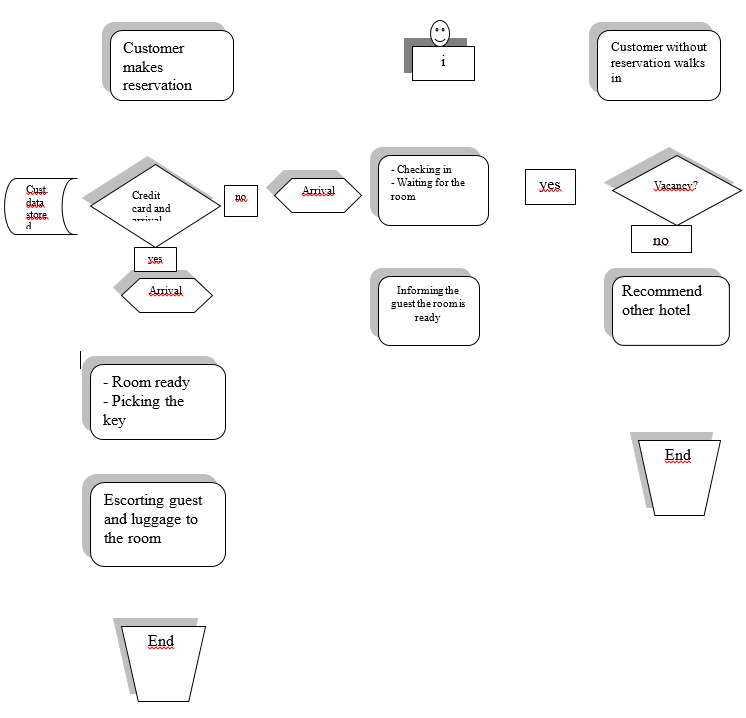
The aforementioned map can be transformed into the following process profile:
In that regard, it can be stated that the main common drivers of process improvement, in this case, are related to the processes that are taking too long, or at its direct consequence, i.e. the customers’ dissatisfaction (Madison, 2005, p. 52). It can be seen from the chart that the potential areas of delay occur as a consequence of conditional areas in the graph, i.e. checking whether the customer provided the credit card information and time of arrival and check the availability of vacancies at the hotel. In that regard, requesting the customers’ credit card information and the estimated time of arrival might reduce the process. Decision points not only might take time, but also might extend the duration of the following processes as well. A potential solution will be to add an additional process owner to the graph, which will handle the guests who did not make a reservation, and/or who did not provide the credit card and date of arrival during reservation. In that regard, the resulting graph can be seen as follows:
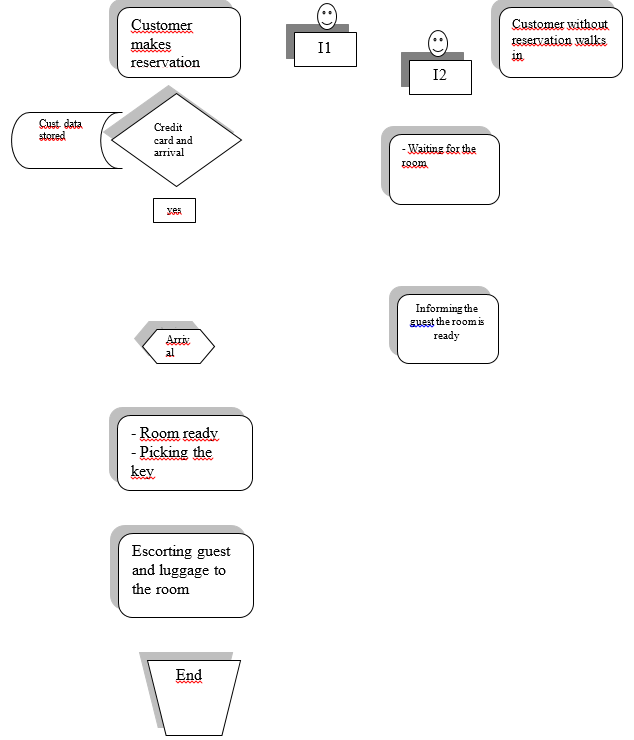
Accordingly, the profile of the process will be modified through the inclusion of a new process owner and new control, in which the duties will be segregated between two employees. The modified profile will be as follows:
It can be stated that the division of the responsibilities between two employees will decrease the load on each one of them, and accordingly will reduce the waiting time for the customers. It can be stated that modifying the process, the process standards will be preserved in this case, where the only difference will be attributed only to the delays in the check-in process. Additionally, the inclusion of other options through the reservation can facilitate the process of check-in at the time when the customers arrive. The added options might include room preferences, and alternative preferences, in case the option will not be available.
Similarly with the check-out procedure, which current operations can be seen in the following graph, the process of improvement might also include modification to process units in order to reduce check-out time.
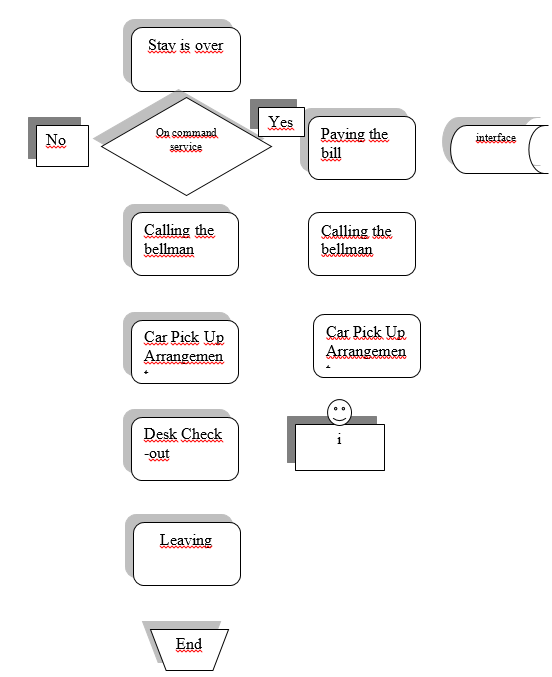
Considering that the processes at the check-out desk are connected to obligatory standards, the redundant activities might be seen in the steps that occur before. The proposed changes can be seen through combining car arrangements and calling the bellman into a single step, where calling the bellman simultaneously triggers the valet for car arrangement. Those customers using the on-command service interface might find an option at which those activities can be triggered as soon as the bill is paid. Accordingly, the modified map for the process might be seen as follows:
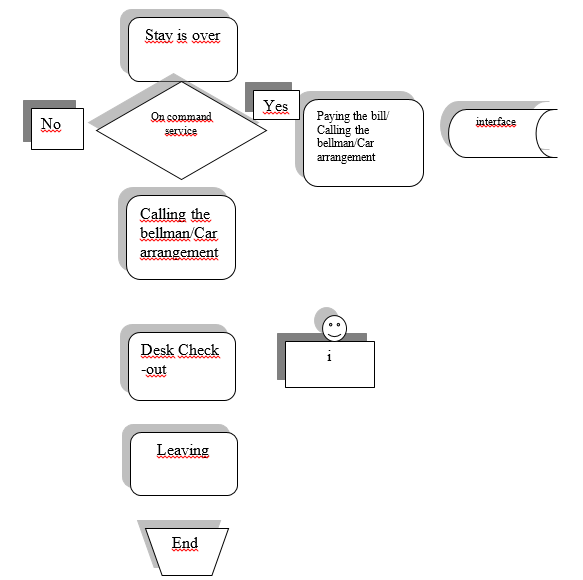
It can be stated that the idea of reducing time through combining the units of a process can be applied to hotels’ offerings as well, as it can be seen from the example of the rental of audio-visual equipment. Usually, the process implies the following steps:
- Contacting customer services.
- Requesting the equipment.
- Checking the availability of the equipment.
- Registering the rental.
- Taking the equipment.
The process map for such a process can be seen in the following graph.
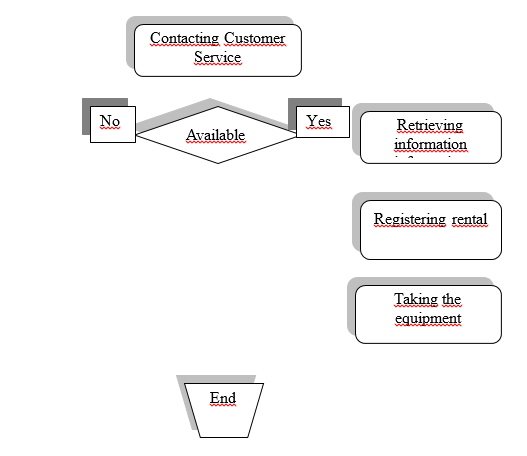
The improvement can be seen through registering such information on customers’ cards, and in such case, the rental registration and the retrieval of customers’ information can be combined in a single step. Such a case will facilitate cases calculation of the bill as well, being performed simultaneously with the check-out. Such improvement will increase the responsiveness of the service, and reduce the time through which the customer will spend on formalities. Accordingly, such a process might increase the satisfaction level of the customers, which in turn can be reflected in hotels’ profitability. The requirements for implementing such step include the following points:
- The equipment for rent
- Bar code scanners
- The managerial functions for such a process, i.e. process owners can be performed by the customer service department.
It can be concluded that the rationale for improving the process in an organization can be seen through conforming to the established standards of quality. Taking the example of the check-in and the check-out processes in Hotel Escargo, the improvement of the process allowed reducing the processing time to the established standards as can be seen through the following graphs.
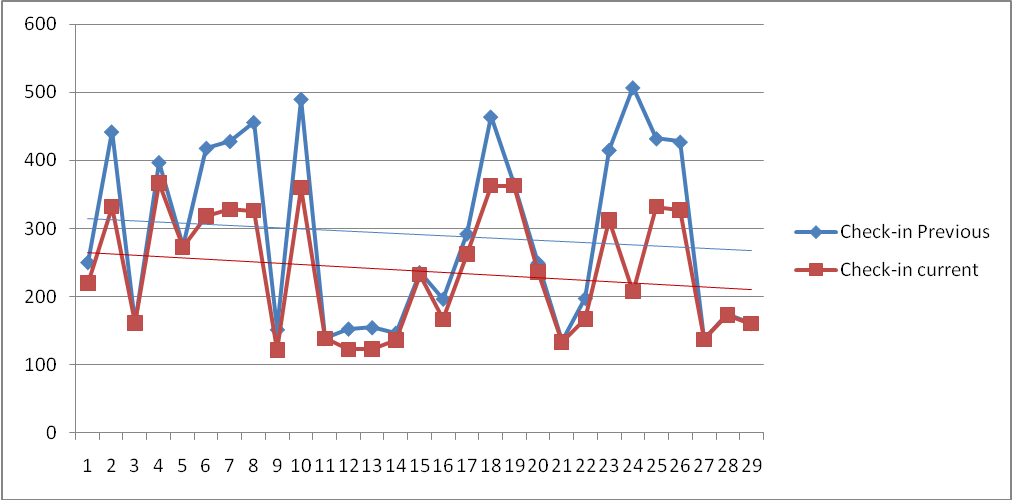
Monitoring and Controlling Future Process Performance
The first step to monitor the performance of business process in an organization is establishing a metric, based on which the performance will be evaluated (Larson, 2003). Accordingly, the metric in this case can be seen in the performance standards such as 4 minutes check-in times, 2 minutes check-out times. Accordingly, the organization can create an additional metric such as the customers’ satisfaction rate, which will be based on regular surveys conducted by the hotel. Linking the aforementioned variables with the objectives of the Hotel, new standards will be established for the company to follow.
In that regard managers can implemented the aforementioned principles through a control phase, i.e. a phase through which the changes made in the process will be maintained, in order to sustain the improvements (Brue, 2002). In this phase the variables linked to the objectives of the company, the satisfaction rates and the process times will be documented and monitored. In that regard, it can be stated that such phase not only will measure the performance, but also will indicate the feasibility of the change, i.e. the correlation between the implemented changes, i.e. the reduction of the waiting time during the check-in and check-out procedures, and the desired outcomes, i.e. the increased satisfaction level of the customers. The plan for monitoring the performance can be outlined as follows:
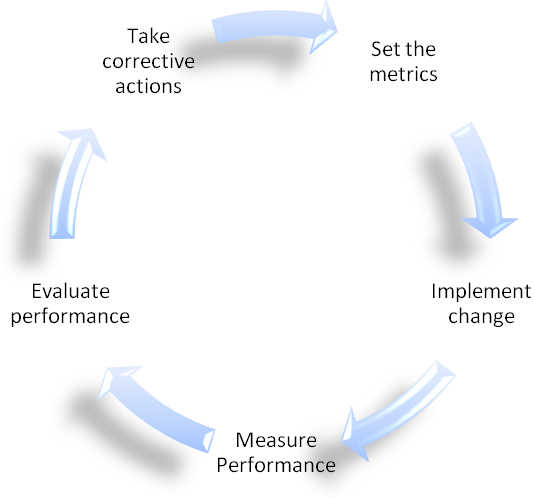
The identification of additional metrics is also important in this case, where the processes involved in improving the quality might go beyond customer service department, e.g. room service, parking valets, and others. At the same time, it should be stated that the metrics that are not correlated with improvements should be omitted. For example, including the time required to clean a room as a metric in this case might reveal that such factor does not correlate with the time the customers have to wait or with their satisfaction level, and thus, such metrics might be reduced during the process of monitoring the performance. In general, the metrics should include only those variables that drive important activities and processes, resulting in relevant information (Brue, 2002, p. 55).
References
Brue, G. (2002). Six Sigma for managers. New York ; London: McGraw-Hill.
Jacka, J. M., & Keller, P. J. (2009). Business process mapping : improving customer satisfaction (2nd ed.). Hoboken, N.J.: Wiley.
Larson, A. (2003). Demystifying six sigma : a company-wide approach to continuous improvement. New York: AMACOM.
Madison, D. (2005). Process mapping, process improvement, and process management: a practical guide for enhancing work and information flow: Paton Professional.
